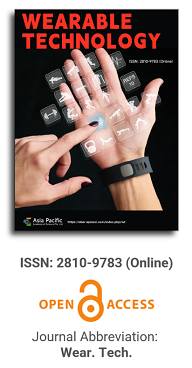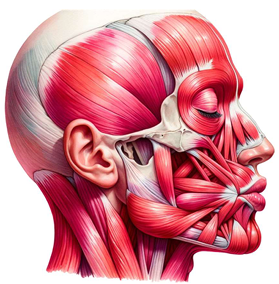

This paper delves deeply into the innovative realm of integrating human emotions with wearable technology. The primary focus is on the conceptualization and development of a kiss transfer device that harnesses the power of wearable technology to bridge the physical gap in human-human interactions. By investigating the intricate nuances of the human-human kissing process, the research seeks to replicate this intimate gesture through a technological medium. The paper not only elaborates on the anatomy, evolution, and hormonal dynamics of kissing but also underscores the transformative potential of wearable technology in capturing and transmitting these intimate moments. This exploration opens up new horizons for long-distance relationships, offering a tangible touchpoint that goes beyond traditional communication methods. Through this pioneering work, the research positions wearable technology as not just a tool for communication but as an extension of our human emotions and expressions.

AR technology in the design of oil and gas field surface engineering: Applications and prospects
Vol 3, Issue 2, 2022
Download PDF
Abstract
Wearable devices based on Augmented Reality (AR) technology can overlay computer-generated images into the real world, whereas simulation is applied to enable users to view the real world with an overlay of digital data. In the past 10 years, AR technology has moved from research laboratories to gradually a wide range of commercially available technologies for its use in the medical, manufacturing, industrial design, entertainment, marketing and military applications. This review includes an overview of AR wearables in the last 5 years including its development milestone and application cases, where specifically, some successful application cases and implications of AR technology in the oil and gas industry in the past five years are reviewed, with the aim of discussing the aspects of AR technology applications in the design of oil and gas field surface engineering, from station and line designs to its use in supporting construction. Since AR technology can provide real-time information, it will have a non-negligible application prospect in the whole lifecycle of oil and gas field surface engineering from design to operation and maintenance and will occupy a place in the digital transformation of the oil and gas industry.
Keywords
References
- Chen C, Li D, Yin H, et al. Development status of smart pipeline system and discussion on its intellectualization application in this specific field. Natural Gas and Oil 2020; 38(5): 133–138.
- Li B, Wang X, Xu B, et al. Operation and management status and intelligentization trend of global oil and gas pipelines. Oil & Gas Storage and Transportation 2019; 38(3): 241–250.
- Azuma RT. A survey of augmented reality. Teleoperators and Virtual Environment 1997; 6(4): 355–385.
- Sutherland IE (1988) Sketchpad: A man-machine graphical communication system. Proceedings of Twenty-Five Years of Electronic Design Automation, 507–524.
- Sutherland IE (1968) A head-mounted three dimensional display. Proceedings of the December 9–11, 1968, Fall Joint Computer Conference, 757–764.
- Billinghurst M, Clark A, Lee G. A survey of augmented reality. Foundations and Trends in Human-Computer Interaction 2015; 8(2–3): 73–272.
- Azuma RT, Baillot Y, Behringe RR, et al. Recent advances in augmented reality. IEEE Computer Graphics and Applications 2001; 21(6): 34–47.
- Azuma RT. The most important challenge facing augmented reality. Teleoperators and Virtual Environments 2016; 25(3): 234–238.
- Azuma RT. The road to ubiquitous consumer augmented reality systems. Human Behavior and Emerging Technologies 2019; 1(1): 26–32.
- Chen J, Wang Y, Yan D. The application of augmented reality. Computer Engineering and Applications 2001; 37(15): 72–75.
- Liu Z, Li S, Li Z. Development and application of augmented reality. Journal of System Simulation 2003; 15(2): 222–225.
- Wang Y, Liu Y, Hu X. Study on key technique and application of outdoor AR system. Journal of System Simulation 2003; 15(3): 329–333.
- Zhu M, Yao Y, Jiang Y. A survey on augmented reality. Journal of Image and Graphics 2004; 9(7): 767–774.
- Qi Y, Ma H. Augmented reality: Characteristics, key technology and applications. Journal of Chinese Computer Systems 2004; 25(5): 900–903.
- Kato H, Billinghurst M (1999) Marker tracking and HMD calibration for a video-based augmented reality conferencing system. Proceedings of the 2nd IEEE and ACM International Symposium on Augmented Reality, 803809.
- IDC. IDC published 10 AR/VR market predictions for 2021. Available at: https://www.idc.com/getdoc.jsp?containerId=prCHC47313321. (Accessed: Feb. 17, 2021)
- Europe’s media in the digital decade: An action plan to support recovery and transformation. European Commission, Brussels, Belgium. Accessed: 2020, pp.12.
- BP. Smarter tech: The consumer electronics revolution coming to the gas field. Available at: https://www.bp.com/en/global/corporate/news-andinsights/reimagining-energy/smarter-technology-in-bp-uslower-48-natural-gas-business.html. (Accessed: Feb. 10, 2021)
- Chevron. How we learned from NASA and the Microsoft hololens team to make virtual teleportation a reality. Available at: https://www.chevron.com/stories/how-we-learned-from-nasa-and-microsoft-hololensteam-to-make-teleportation-a-reality. (Accessed: Feb. 10, 2021)
- Honeywell. Honeywell introduces new intelligent wearables forindustrial field workers. Available at: https://www.honeywell.com/us/en/press/2018/05/honeywell-introduces-new-intelligent-wearables-forindustrial-field-workers. (Accessed: Feb. 10, 2021)
- De Souza CLF, Mariano FCMQ, Zorzal ER. A survey of industrial augmented reality. Computers & Industrial Engineering 2020; 139: 106159.1–106159.12.
- Augmented reality in oil and gas. Global Data, London, U.K., 2020, pp.3.
- Wang J, Li M, Geng W, et al. Scene planning system based on augmented reality technique. Journal of Image and Graphics; 7A(4): 95–100.
- Guan T, Li L. The application research of augmented reality in residential area planning. Journal of Engineering Graphics 2006; 27(5): 50–54.
- Shen J, Liu H. Application of augmented reality (AR) technique to the evaluation of projects. Journal of Xi’an Petroleum University (Natural Science Edition) 2001; 16(4): 79–84.
- Phan VT, Choo SY. A combination of augmented reality and google earth’s facilities for urban planning in idea stage. International Journal of Computer Applications 2010; 4(3): 26–34.
- Sun M, Chern X, Zhang F, et al. Augment reality geographical information system. Acta Scientiarum Naturalium Universitatis Pekinensis 2004; 40(6): 906–913.
- Chang Y, He Z. Technology of augmented reality and its application in 3D visualization of underground pipeline. Bulletin of Surveying and Mapping 2005; (11): 57–60.
- Zhou L, Chen Q. Research on augmented reality system of urban underground pipe network. Computer Engineering and Applications 2020; 56(1): 251–256.
- He B, Zhang S, Qiu W, et al. Overview on application of augmented reality technology in engineering construction. Journal of Civil Engineering and Management 2020; 37(2): 93–98.
- Yan W, Ren L, Song G, et al. Digital collaborative design supports the construction of intelligent oil & gas fields. Natural Gas and Oil 2018; 36(3): 110–115.
- Tang X, Sun Z, Wang H, et al. Research on standardization system of intelligent oil and gas fields. Natural Gas and Oil 2019; 37(5): 115–118.
- Wang H. A study on digital delivery of smart oil and gas field. Natural Gas and Oil 2020; 38(3): 108–111.
- Li Z, Wang J, Wang X, et al. Construction of intelligent pipeline system in the era of smart energy. Oil & Gas Storage and Transportation 2017; 36(11): 1243–1250.
- Li H. The status quo & development trend of smart pipeline technology. Natural Gas and Oil 2018; 36(2): 129–132.
Supporting Agencies
Copyright (c) 2022 Haoli Cheng, Zhongmin Liu, Fengfeng Cai, Lianlai Zhang, Xiaotian Ma, Xueyi Sun, Jingmin Hu, Peng Wang

This work is licensed under a Creative Commons Attribution 4.0 International License.

Prof. Zhen Cao
College of Information Science & Electronic Engineering, Zhejiang University
China, China
Processing Speed
-
-
-
- <5 days from submission to initial review decision;
- 62% acceptance rate
-
-
Asia Pacific Academy of Science Pte. Ltd. (APACSCI) specializes in international journal publishing. APACSCI adopts the open access publishing model and provides an important communication bridge for academic groups whose interest fields include engineering, technology, medicine, computer, mathematics, agriculture and forestry, and environment.





